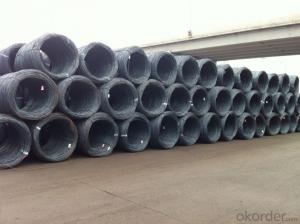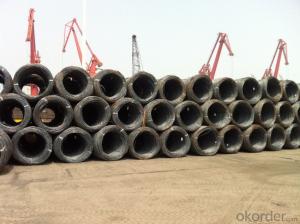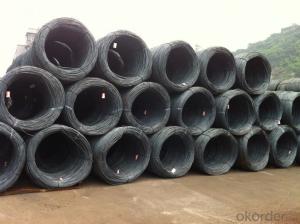Hot Rolled Wire Rods Best Quality and Price
- Loading Port:
- Tianjin
- Payment Terms:
- TT OR LC
- Min Order Qty:
- 25 m.t.
- Supply Capability:
- 20000 m.t./month
OKorder Service Pledge
OKorder Financial Service
You Might Also Like
Item specifice
Grade: SAE1008 Standard: ASTM
Diameter: 5.5mm, 6.5mm, 7mm, 8mm, 9mm, 10mm, 11mm, 12mm
Alloy or Not: Alloy
Technique: Hot Rolled Place of Origin: China Mainland
Chemical Composition:
Please kindly find our chemistry of our material based on SAE1008 as below for your reference:
Grade | Chemical Composition (%) | |||||
C | Mn | S | P | Si | B | |
SAE1008 | 0.10max | 0.30-0.50 | 0.050max | 0.040max | 0.30max | 0.0008min |
Mechanical properties | ||||||
Yield strength(N/mm2) | Tensile strength(N/mm2) | Elongation (%) | ||||
≥195 | 350-380 | ≥32 | ||||
Usage and Applications of Wire Rod:
After hot-rolled the products shaped into coil and delivery as finished product, including round, square,rectangular, hexagonal and so on. Since most of the products are round, it is generally called wire rod. Carbon steel wire rod is widely used in construction and manufacturing. Carbon steel wire rod is mainly used for reinforcement of reinforced concrete and welded structure or reprocessed (roberts , nail, etc.) materials, especially used to produce wire drawing, welding electrode, nails, spring, electronic, precise machinery parts and so on.
Packaging & Delivery of Wire Rod:
Packaging Detail: products are packed in coil and then shipped by container or bulk vessel
Each coil weight: About 2.05MT
Delivery Detail: within 45 days after received deposit or LC.
Label: to be specified by customer, generally, each bundle has 1-2 labels
Trade terms: FOB, CFR, CIF
FAQ:
Q1: How soon can we receive the product after purchasement?
A1: Within three days of placing an order, we will begin production. The specific shipping date is dependent upon international and government factors, but is typically one month.
Q2: How do you guarantee the quality of our products?
A2: We have established an advanced quality management system which conducts strict quality tests at every step, from raw materials to the final product. At the same time, we provide extensive follow-up service assurances as required.
Q3:What's your payment terms ?
A3:Mostly,we collect the money by T/T and LC at sight . We also accept time LC at 90/120 days sight.
Images of Wire Rod
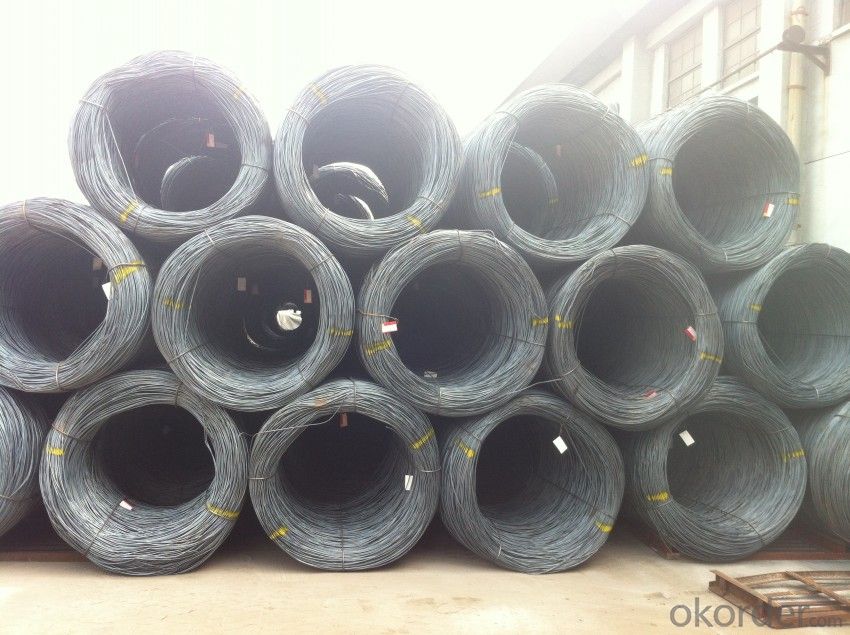
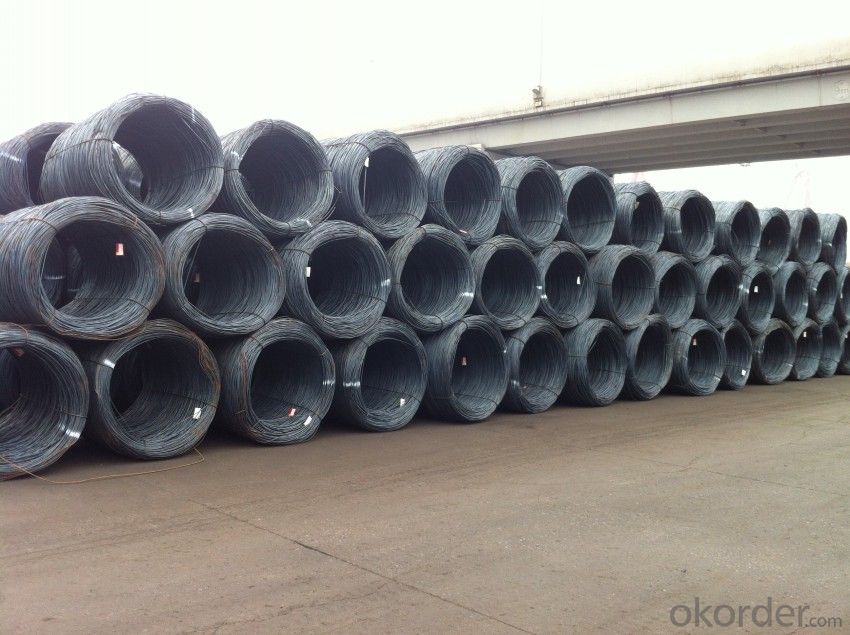
- Q:How is steel wire rod used in the manufacturing of wire mesh for concrete reinforcement?
- Steel wire rod is used in the manufacturing of wire mesh for concrete reinforcement by being formed into a grid-like pattern. This wire mesh is then embedded within the concrete to provide added strength and stability, preventing cracking and ensuring durability. The steel wire rod acts as a reinforcement, distributing the load and increasing the overall structural integrity of the concrete.
- Q:What are the main factors influencing the choice of steel wire rod after-sales service?
- There are several key factors that influence the selection of after-sales service for steel wire rods. Firstly, the quality of the service provided is of utmost importance. Customers expect prompt and effective support, including timely responses to inquiries, technical assistance, and problem resolution. A dependable after-sales service ensures customer satisfaction and fosters trust in the supplier. Secondly, the availability and accessibility of spare parts and components are crucial considerations. Customers anticipate suppliers to have readily available stocks of spare parts to swiftly address any issues with the steel wire rods. This minimizes downtime and guarantees uninterrupted production. In addition, the expertise and knowledge of the after-sales service team are critical factors. Customers value suppliers who employ well-trained and experienced service technicians capable of providing expert guidance and advice. This assists customers in optimizing the performance of the steel wire rods and addressing any operational challenges they may face. Another influential factor is the cost-effectiveness of the after-sales service. Customers seek service packages that offer value for money, including reasonable prices for spare parts, maintenance contracts, and repair services. A cost-effective after-sales service ensures that customers receive the necessary support without incurring significant additional expenses. Furthermore, the geographical coverage and response time of the after-sales service team are taken into account. Customers prefer suppliers with extensive service networks, enabling them to receive support even in remote locations. Additionally, a quick response time is crucial for minimizing production downtime and maintaining efficient operations. Lastly, customer feedback and reputation also impact the selection of after-sales service for steel wire rods. Positive testimonials and references from existing customers can instill confidence in potential buyers. Therefore, suppliers who consistently receive positive feedback and have a strong reputation for excellent after-sales service are more likely to be favored. In conclusion, the choice of after-sales service for steel wire rods is influenced by factors such as service quality, spare part availability, service team expertise, cost-effectiveness, geographical coverage, and reputation. By considering these factors, customers can make informed decisions and select suppliers that meet their after-sales service expectations.
- Q:What are the factors that affect the cost of steel wire rod?
- The cost of steel wire rod can be affected by several factors. Firstly, the price of the raw materials used to produce steel wire rod, such as iron ore and scrap metal, heavily influences its cost. Any fluctuations in these raw material prices can directly impact the cost of steel wire rod. Secondly, the cost of producing steel wire rod includes various expenses like labor, energy, and equipment maintenance. Changes in these production and manufacturing costs can affect the overall cost of the product. Thirdly, the demand for steel wire rod plays a significant role in its cost. If there is high demand and limited supply, the price of steel wire rod may increase. Conversely, if there is low demand and excess supply, the price may decrease. Furthermore, market competition among steel wire rod manufacturers can also impact its cost. Intense competition can lead to lower prices as companies strive to attract customers. Conversely, a lack of competition may result in higher prices. Additionally, the cost of transporting steel wire rod from manufacturers to end-users contributes to its overall cost. Factors such as fuel prices, distance, and transportation infrastructure can affect these costs. Moreover, government regulations and policies, like import duties, export restrictions, or environmental regulations, can impact the cost of steel wire rod. Compliance with these regulations may require additional investments, influencing the product's price. Lastly, exchange rate fluctuations can impact the cost of steel wire rod in different countries. Changes in currency values can affect the import and export prices of steel wire rod, influencing its overall cost. To make informed decisions and strategies regarding the cost of steel wire rod, businesses should monitor and understand these factors.
- Q:How are surface defects in steel wire rod repaired?
- Surface defects in steel wire rods can be repaired through various methods depending on the type and extent of the defect. Some common surface defects include scale, cracks, pits, and scratches. Here are a few methods used to repair these defects: 1. Grinding and polishing: Surface defects like scratches and pits can be repaired by using grinding and polishing techniques. This involves removing the damaged layer of steel and smoothing the surface with abrasive tools. The process is repeated until the defect is completely eliminated, and the surface is restored to its desired finish. 2. Heat treatment: Some surface defects, such as cracks, can be repaired through heat treatment methods. Heat treatment involves subjecting the steel wire rod to controlled heating and cooling processes to alter its physical and mechanical properties. This can help close the cracks and improve the overall integrity of the wire rod. 3. Mechanical removal: For larger defects like scale or excessive surface irregularities, mechanical removal methods are used. This can involve using specialized tools or machinery to physically remove the defective portion of the wire rod. The remaining surface is then treated to ensure it meets the required specifications. 4. Chemical treatment: Certain surface defects, such as rust or corrosion, can be repaired using chemical treatment methods. This involves applying appropriate chemicals or coatings to the affected area to remove the corrosion and prevent further deterioration. The treated surface is then cleaned and prepared for further processing or use. It is important to note that the repair process for surface defects may vary depending on the specific requirements and standards of the steel wire rod industry. Manufacturers and technicians follow industry guidelines and quality control measures to ensure the repaired wire rods meet the necessary specifications for their intended applications.
- Q:How is steel wire rod used in the manufacturing of wire forms for wind turbines?
- Steel wire rod is a crucial ingredient in the production process of wire forms used in wind turbines. It acts as the primary material that undergoes several processes to become the final wire forms applied in wind turbine applications. To start with, steel wire rod is chosen for its exceptional strength and durability to endure the harsh environmental conditions and heavy loads encountered by wind turbines. Typically, the wire rod is made of low carbon steel, which offers the desired blend of strength and flexibility. The manufacturing process commences with the wire rod being fed into a wire drawing machine. This machine pulls the wire rod through a sequence of dies, gradually reducing its diameter and increasing its length. This operation, known as wire drawing, enhances the wire's mechanical properties, including tensile strength and surface finish. Once the wire has been drawn to the desired diameter, it is ready for further processing. It may undergo additional treatments like heat treatment or surface coating to enhance its properties. Heat treatment can improve strength and flexibility, while surface coating can provide protection against corrosion and abrasion. After the necessary treatments, the wire is then shaped into the desired form for wind turbine components. This can be accomplished through various methods such as bending, twisting, or welding. These shaping processes are critical in creating wire forms capable of effectively supporting and transmitting the mechanical loads experienced by wind turbines. The wire forms manufactured from steel wire rod find applications in various aspects of wind turbines. They can serve as support structures for the blades, offering stability and strength. Additionally, wire forms are employed as electrical conductors, transmitting power generated by the wind turbine to the electrical grid. In conclusion, steel wire rod plays a vital role in the production of wire forms for wind turbines. Its high strength, durability, and versatility make it an ideal material for withstanding the demanding conditions and loads experienced by wind turbines. Through various processes, the wire rod is transformed into wire forms that act as crucial components in wind turbine construction and operation.
- Q:How is steel wire rod stored and protected from corrosion?
- Steel wire rods are typically stored in dry and well-ventilated areas to prevent moisture accumulation, as moisture can accelerate corrosion. They are often kept in stacks or on racks with adequate spacing between each rod to allow for air circulation. Additionally, steel wire rods are protected from corrosion by applying a coating or using corrosion-resistant materials such as galvanized or stainless steel. Regular inspections and maintenance are conducted to ensure the storage conditions are optimal and any signs of corrosion are promptly addressed.
- Q:How does the electrical conductivity of steel wire rod vary with different grades?
- The electrical conductivity of steel wire rod varies with different grades due to variations in the composition and microstructure of the steel. Higher grade steel wire rods, typically with higher carbon content, tend to have lower electrical conductivity compared to lower grade steel wire rods. This is because higher carbon content in the steel leads to more impurities and a less uniform crystal lattice, which hinders the movement of electrons, resulting in lower electrical conductivity. Conversely, lower grade steel wire rods, with lower carbon content and fewer impurities, exhibit higher electrical conductivity.
- Q:How is steel wire rod used in the manufacturing of fences and meshes?
- Steel wire rod is commonly used in the manufacturing of fences and meshes due to its high strength and durability. It is typically shaped, cut, and welded to create the desired fence or mesh structure. The wire rod is essential for providing stability and security, as it can withstand tension and prevent the fence or mesh from being easily damaged or breached.
- Q:How is the steel wire rod market affected by technological advancements?
- Technological advancements have significantly impacted the steel wire rod market. These advancements have led to the development of more efficient and advanced manufacturing processes, resulting in increased production capacities and improved product quality. Automation and digitization have also played a crucial role in streamlining operations and reducing production costs. Moreover, technological innovations have led to the introduction of new steel wire rod grades with enhanced properties, meeting the evolving demands of various industries. Overall, technological advancements have positively influenced the steel wire rod market by driving growth, improving productivity, and offering innovative solutions to customers.
- Q:How is steel wire rod used in the manufacturing of wire forms for automotive cooling systems?
- Steel wire rod is used in the manufacturing of wire forms for automotive cooling systems as it provides strength, durability, and resistance to corrosion. These wire forms are utilized in various components such as radiator support brackets, fan guards, and hose clamps. The steel wire rod is first drawn into the desired diameter and then undergoes processes like bending, cutting, and welding to create the required wire forms. These wire forms play a crucial role in ensuring the efficiency and functionality of automotive cooling systems by providing structural support, securing components, and maintaining proper airflow.
1. Manufacturer Overview |
|
|---|---|
| Location | |
| Year Established | |
| Annual Output Value | |
| Main Markets | |
| Company Certifications | |
2. Manufacturer Certificates |
|
|---|---|
| a) Certification Name | |
| Range | |
| Reference | |
| Validity Period | |
3. Manufacturer Capability |
|
|---|---|
| a)Trade Capacity | |
| Nearest Port | |
| Export Percentage | |
| No.of Employees in Trade Department | |
| Language Spoken: | |
| b)Factory Information | |
| Factory Size: | |
| No. of Production Lines | |
| Contract Manufacturing | |
| Product Price Range | |
Send your message to us
Hot Rolled Wire Rods Best Quality and Price
- Loading Port:
- Tianjin
- Payment Terms:
- TT OR LC
- Min Order Qty:
- 25 m.t.
- Supply Capability:
- 20000 m.t./month
OKorder Service Pledge
OKorder Financial Service
Similar products
New products
Hot products
Hot Searches
Related keywords
